To boost your YouTube video rankings, it's crucial to maintain viewer engagement through high-quality content. This lesson will guide you in optimizing audience retention and other key ranking factors that influence your position on YouTube.
This article is part of our free YouTube Growth Course. In total, there are four lessons in this course. This is part 2.
- Part 1. YouTube Keyword Research: How To Get More Views?
- 👉 You're here: Part 2. How To Create Engaging YouTube Videos That Rank Higher
- Part 3. YouTube SEO 101: How To Boost Your Videos Search Ranking
- Part 4. Effective YouTube Video Promotion: Strategies to Boost Reach
In the early days, YouTube's then-primitive "algorithms" relied merely on view counts for rankings.
Thankfully, those days are behind us, which means things have become more challenging.
However, this shift has led to improved relevance and higher-quality results on YouTube, enhancing the overall user experience. That's arguably a good thing. 🙂
Today, what matters most are viewer engagement and user signals.
Once you grasp a fundamental concept about YouTube, everything becomes clearer:
YouTube has a clear interest in providing the most relevant results and keeping people on their platform as long as possible so they can show more ads.
– Adam Moore, Co-founder of SocialPlus
If you help YouTube achieve that they'll boost your reach and rankings, while failing to do so will result in your videos being pushed to the bottom of feeds and search results.
To put it plainly, if your video fails to captivate and retain viewers, no amount of SEO optimization will propel it to rank.
(Of course, there are exceptions, but if you aspire to rank in the top 10 for competitive keywords, you must offer engaging and valuable content—or someone else will.)
Now that we've clarified this, let's look into the significance of audience retention.
Understanding Audience Retention: All You Need to Know
YouTube emphasizes the significance of audience retention, and ideally, you'd want to maintain it as close to 100% as possible. But what exactly is audience retention?
In simple terms, it measures how long the average viewer watches your video.
Or as YouTube explains it: "Audience retention is a measurement of how many people are still watching your video during your video playback. It also shows you when viewers stop watching."
So, why does it matter so much?
A high audience retention rate is a crucial ranking factor. For instance, if a significant portion of viewers drops off within the first 10 seconds, it signals to YouTube that your video didn't meet their expectations, which is not good.
In contrast, if people keep watching your video until the end, YouTube interprets it as your video being engaging or providing valuable information.
"Understanding when viewers maintain interest or when they stop watching your video can provide insights into areas of your video that are performing well and areas that need improvement."
Failing to create engaging content will lead viewers to return to the search results and click on another video, and you definitely want to avoid that.
YouTube is aware of these user behaviors, and if a substantial percentage of viewers clicks away from your video shortly after starting it, YouTube will lower its ranking in favor of a result that performs better.
So, how do you craft and publish a video that keeps people engaged? This is precisely what we'll explore in this lesson to help you create outstanding videos that also rank higher as a result.
How to view and analyze audience retention on YouTube
YouTube offers creators some of the most comprehensive analytics among social networks.
Regularly monitoring and analyzing audience retention data is crucial for improving and refining your content strategy and keeping viewers engaged throughout your videos.
Here's how to view and analyze audience retention on YouTube:
- Access Your YouTube Studio: Log in to your YouTube account, and click on your profile icon in the upper right corner. From the dropdown menu, select "YouTube Studio."
- Navigate to the Video Details: In the YouTube Studio, click on "Videos" in the left-hand sidebar. This will display a list of your uploaded videos.
- Select a Video: Choose the video you want to analyze audience retention for by clicking on its title.
- Go to the Analytics Tab: Once you're on the video's details page, click on the "Analytics" tab located on the left sidebar, below the "Video details" heading.
- Access Audience Retention Data: In the Analytics section, you'll find a variety of data. Scroll down to find the "Audience retention" card. Click on it to view detailed information.
Analyze the Graphs
You'll see graphs that depict audience retention over the course of your video. These graphs show how long viewers watched your video before dropping off. Pay close attention to any significant drop-offs and try to identify patterns.
Refer to the screenshot below for further guidance on interpreting these graphs.
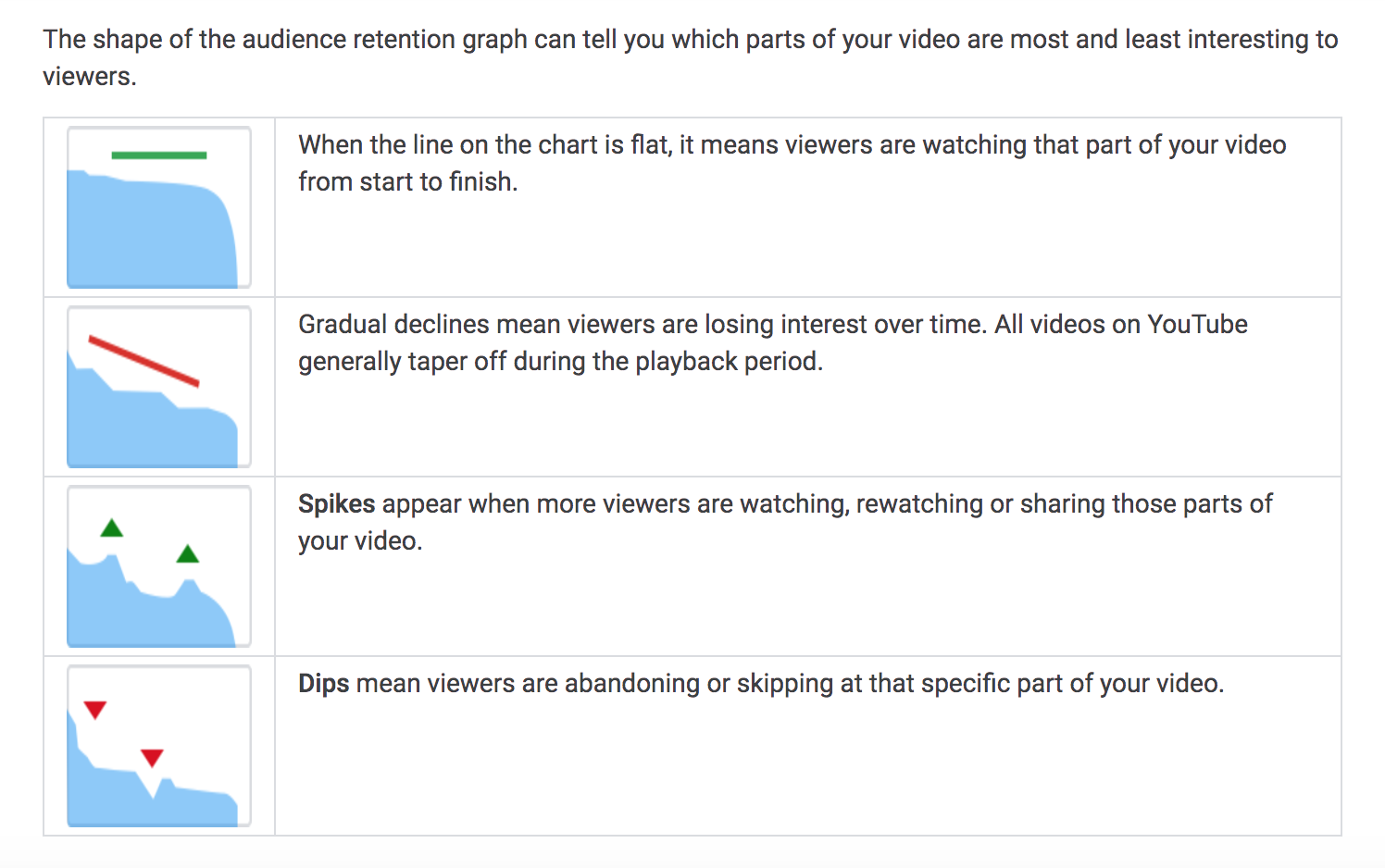
Bonus tips
Use the Timeline: Below the graphs, you'll find a timeline that you can drag and drop to see audience retention data at specific points in your video. This can help pinpoint where viewers tend to lose interest.
Analyze for Improvement: Based on your analysis, consider what aspects of your video may have contributed to viewer drop-offs. Did you lose viewers during a certain segment? Were there abrupt changes or a lack of engaging content? Use these insights to improve your future videos.
How to Improve Audience Retention
Here are 3 best practices that you should apply to your videos, to improve your audience retention.
These practices are instrumental in improving audience retention and engaging your viewers effectively.
Understanding your audience is crucial for any successful marketing strategy.
1. Set Viewer Expectations from the Start
It may sound simple, but it's incredibly effective.
The beginning of your video, often referred to as the intro, plays a vital role in hooking your viewers.
Our recommendation is to begin your video by clearly stating its topic and how it can benefit viewers looking for information on that subject—in less than 15 seconds.
For example, in this well-optimized video, the creator begins by stating precisely what the video is about:
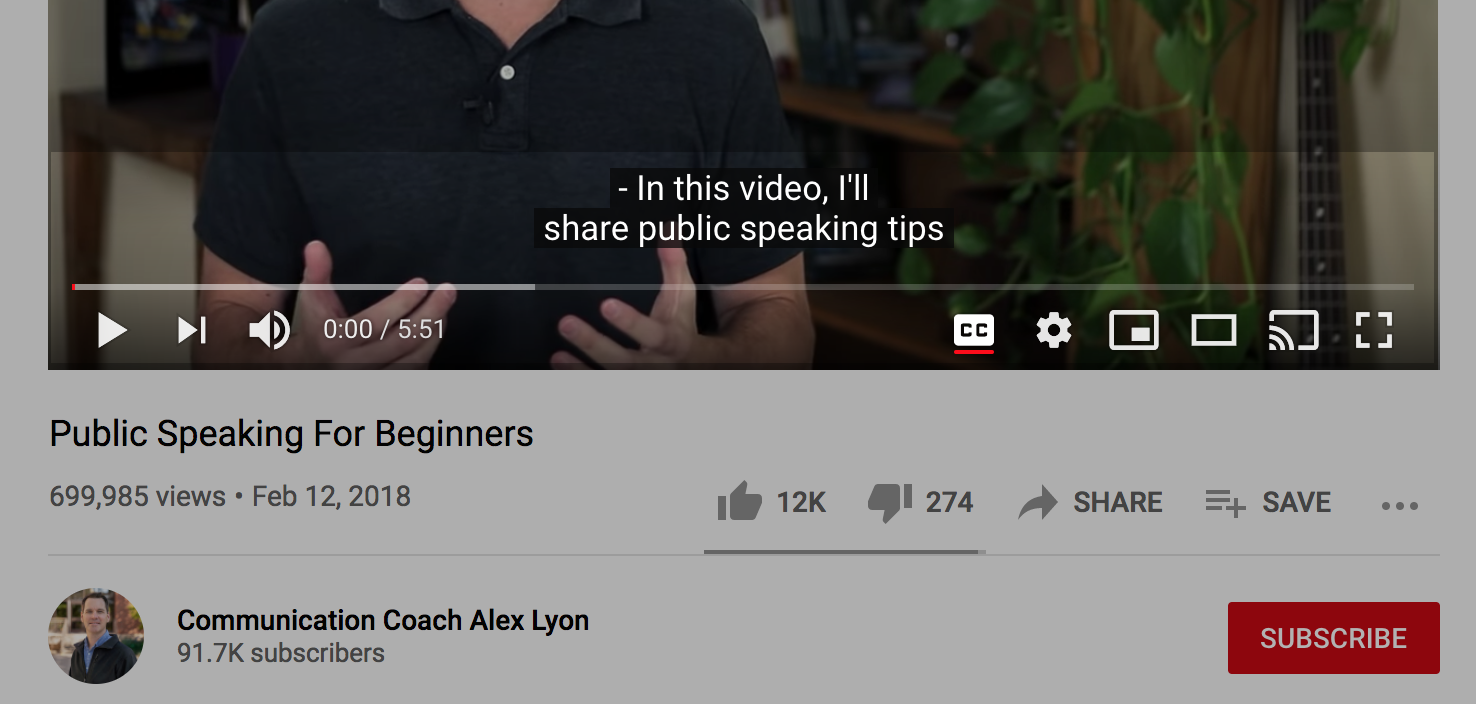
"- In this video, I'll share public speaking tips for beginners."
"So if you're just getting started in your stand-up speaking experience, this video is for you."
"So let's unpack the details."
Notice how he smoothly incorporates his target keywords, "public speaking tips" and "public speaking tips for beginners," right from the start.
This technique serves multiple purposes, as we'll discuss later in this lesson.
(By the way, did you catch the "Open loop" technique I used there? We'll dive into that below.)
2. Get to the Point Quickly
Do you enjoy wasting your time? Most likely, your answer is a resounding no.
It's safe to assume that your viewers share the same sentiment. So, after your brief introduction, it's essential to dive right into the heart of your video.
A glaring example of what not to do is advertising an entirely unrelated product. You've probably encountered this on YouTube a few times.
Lately, many creators insert promotions for VPNs and similar products seemingly out of nowhere in their videos.
While we respect creators trying to monetize their content, ill-placed advertisements can be highly bothersome and, unfortunately, detrimental to audience retention.
Consequently, people may try to skip past the ads or exit your video altogether, causing a negative impact on your audience retention.
Of course, advertising can work effectively when it remains relevant to your video's topic.
A prime example is when you're doing a makeup tutorial and promote makeup products—this is 100% relevant and beneficial to your viewers.
3. Use Open Loops
Open loops are a powerful method to engage viewers for longer durations and boost audience retention.
This storytelling technique has been around for ages, and you might have employed it without even realizing it.
You've likely encountered open loops in popular TV series, where they drop subtle hints or teasers about what's coming next.
To grasp why this technique is so effective, let's delve into how the human brain functions.
(Don't worry. You don't need a degree in psychology or brain science for this, though it might help 😉)
So, what exactly are open loops?
Essentially, when you "open" a loop or introduce an unresolved task relevant to your content, the human brain instinctively wants to "close" or resolve that loop to move forward.
Numerous studies have explored this phenomenon.
This sense of tension created by the open loop can heighten viewer awareness, as they eagerly anticipate its resolution.
Of course, you'd ideally want to "close" the loop near the end of your video to maximize audience retention, if it aligns with your content.
However, avoid dragging it out excessively.
"Closing" the loop
For instance, earlier in this lesson, I provided an example of opening a loop:
"This technique serves multiple purposes, as we'll discuss later in this lesson."
Now, why is it important to mention your target keyword at the beginning of your video?
Well, today, YouTube can understand the spoken content in videos quite accurately, evident from the automatically generated captions.
Saying your target keyword helps YouTube understand your video's subject matter.
✅ Congratulations, you've just closed the loop! 🙂
4. Leverage End Screens
End screens prove highly effective in encouraging viewers to subscribe or watch your earlier content.
We highly recommend incorporating these into your videos, a straightforward process achievable through the YouTube Studio dashboard.
How to add End Screens on YouTube
- Access YouTube Studio: Log in to your YouTube account and navigate to the YouTube Studio dashboard.
- Select the Video: Choose the video to which you want to add an end screen by clicking on "Videos" and then selecting the specific video.
- Edit Video Details: In the video details section, click on "Editor."
- Add End Screen Elements: In the video editor, you'll see an option for "End Screen." Click on it to start adding end screen elements.
- Choose Elements: You can add various elements like subscribe buttons, video or playlist links, and channel links. Select the ones that best suit your video's goals.
- Position and Size: Drag and drop the elements to the desired location on the video timeline. Adjust their size and duration to ensure they don't interfere with the video's content.
- Preview and Save: Use the preview feature to see how your end screen will appear. Make any necessary adjustments. Once satisfied, save your changes.
Optimizing your end screens involves making them engaging and relevant to your video's content and audience.
Encourage viewers to take action by using compelling call-to-action text and visuals, and strategically place end screen elements where they won't disrupt the viewing experience.
Regularly analyze the performance of your end screens to see what works best for retaining viewers and driving engagement.
Exploring Other Vital Ranking Factors
With audience retention covered, it's essential to understand that YouTube considers multiple ranking factors within its algorithms.
Creating a high retention video doesn't demand expensive equipment like cameras or microphones.
As long as your video offers value, entertainment, and pertinent information, you're on the right track.
Below are some additional key ranking factors on YouTube that you should also focus on enhancing:
Important YouTube Ranking Factors
Let's explore a few more significant ranking factors on YouTube that are worth understanding.
By adhering to these best practices, you can enhance your likelihood of achieving higher rankings and appearing in feeds and recommendations alongside similar videos.
1. People commenting on your video
When viewers comment and engage with your video, it sends a clear message to YouTube.
It indicates that your video is valuable enough to prompt viewers to share their thoughts and feedback, which holds significant importance.
Encouraging viewer comments is a practice you should consistently follow.
The simplest way to boost engagement is by asking for it.
You can do this by prompting viewers to suggest topics of interest for new videos or share their thoughts on the video they've just watched.
Creating engaging videos may take time and involve some trial and error before you get it right. However, the results can be truly remarkable once you do.
Additionally, make sure to respond to comments to build a relationship with your audience.
This interaction fosters a sense of community and can lead to more engagement in the long run.
2. Click-Through Rate (CTR)
CTR, or Click-Through Rate, is an often-overlooked yet highly crucial ranking factor.
Think of it this way: When someone searches for content on YouTube, which video result are they more likely to click on? Yours or another video?
Naturally, the higher your CTR, the better your rankings will be.
But what exactly is CTR?
CTR is the percentage of people who click on your video compared to the other search results.
Why does it matter?
CTR is a user behavior that YouTube closely monitors.
If many people click on your video, YouTube takes notice and thinks, "Hey, this video seems popular. Let's boost its rankings."
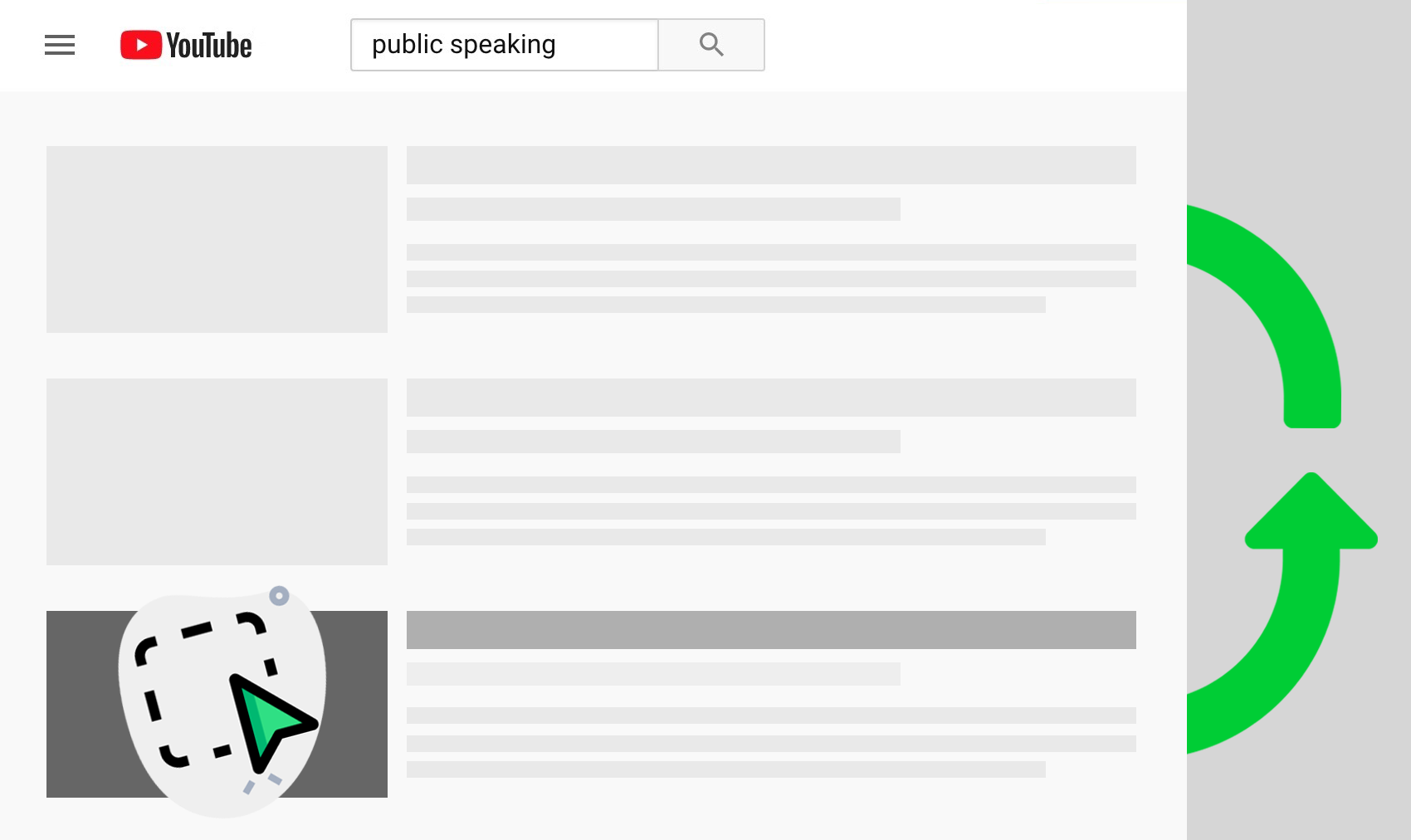
On the flip side, if people consistently skip your video in search results, your rankings will likely drop.
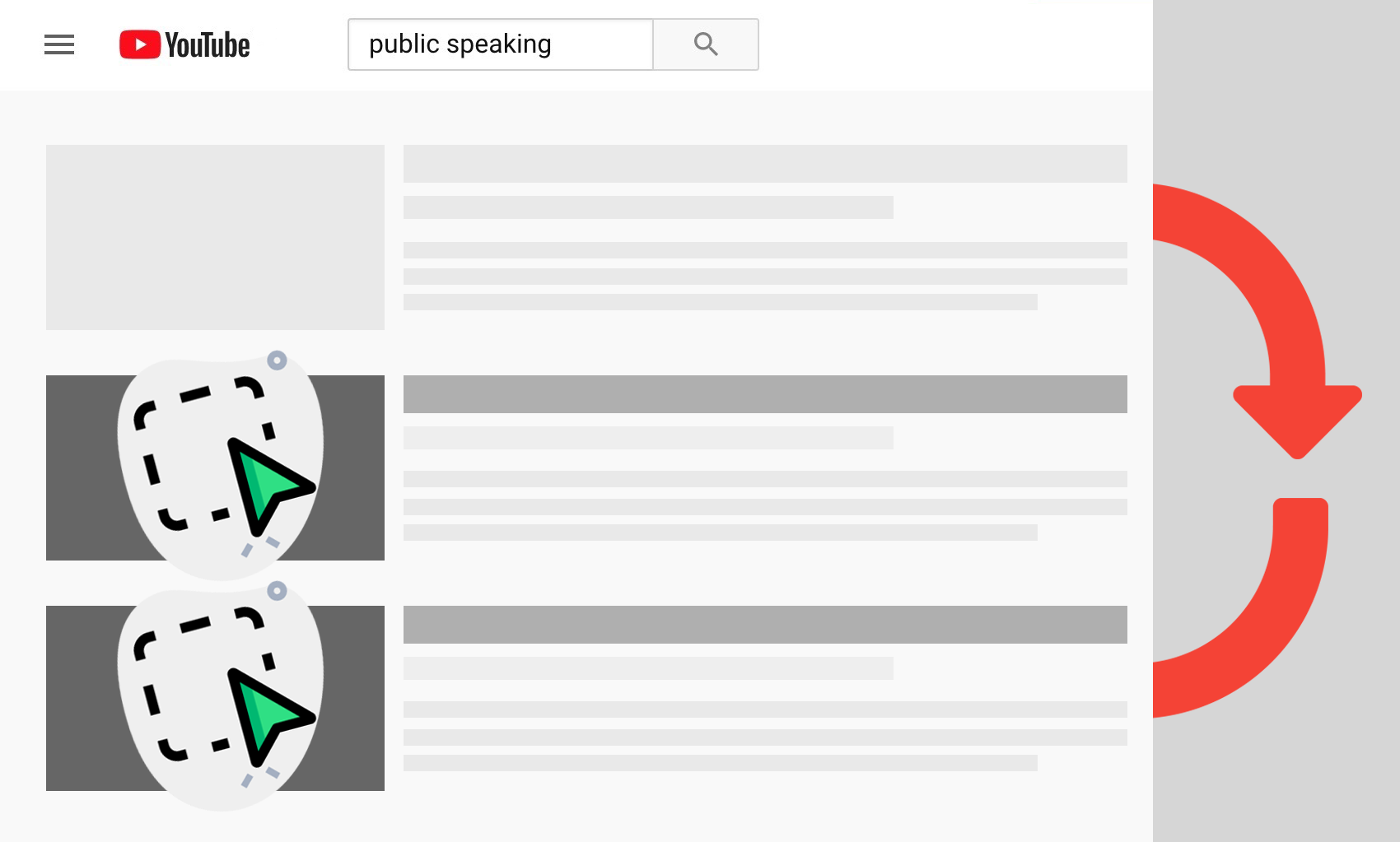
However, it's important to note that getting people to click is just one part of the equation.
Keeping them engaged once they've clicked is equally vital.
So, how can you effectively improve your CTR?
Create eye-catching thumbnails and titles that stand out from the rest but remain unique without being spammy.
We'll look deeper into optimizing your video's search engine optimization in the next lesson, where we'll explore ways to improve your CTR among other factors.
But wait, wouldn't my video need to show up in the first place?
You are absolutely right! Getting people to click on your video obviously relies on them seeing it in their feed or search results in the first place.
Most viewers only look at the top 20 results, where they typically find relevant and helpful content.
This is why gaining traction on YouTube can be challenging, especially with no views or engagement.
It's one reason why a lot of prominent creators opt for buying views and engagement to kickstart their organic growth on the platform.
3. Subscribing During or After Watching
One of YouTube's unique features, unlike many other social media platforms, is that viewers can subscribe directly to your channel from your videos.
In fact, most of your gained subscribers will likely come from your videos.
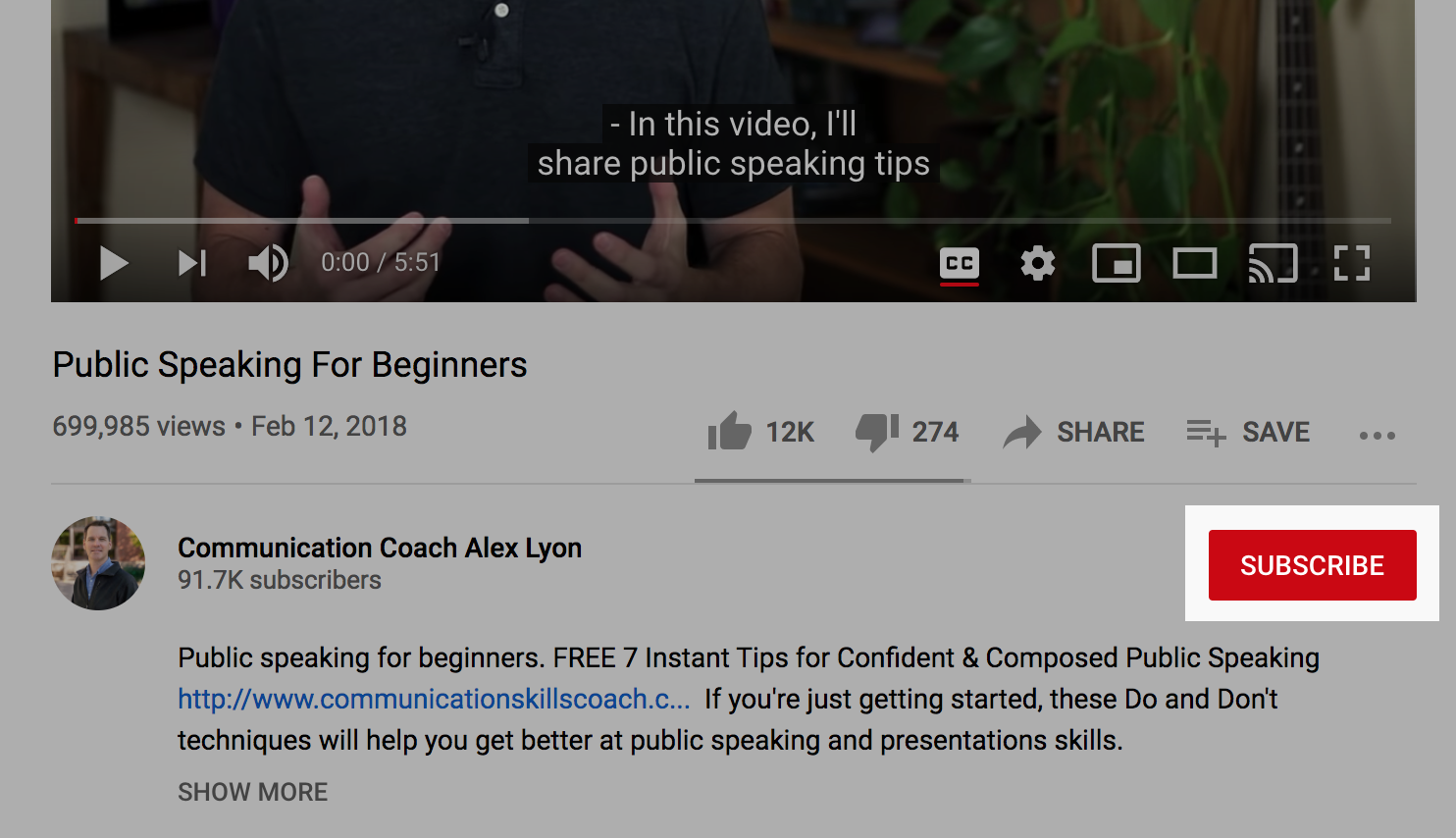
When someone subscribes to your channel while watching or afterward, it sends a clear signal to YouTube.
It indicates that the viewer found your content helpful and wishes to stay connected for more similar content. This is a strong ranking signal.
But how can you encourage people to subscribe? Simply ask them.
Asking your viewers to subscribe is the easiest way to gain more subscribers. Ideally, you should mention it at least 2-3 times during your video, as long as it feels natural.
Avoid the mistake of only mentioning it at the end of your video, after the viewer has already obtained the information they needed.
As mentioned earlier, audience retention gradually declines over the course of a video, which is typical for all videos.
Therefore, it's a good practice to mention subscribing a few times throughout your video to maximize your chances of gaining subscribers and likes.
4. Shares on Social Media and High Authority Sites
When someone shares your video on platforms like Facebook, Twitter, Reddit, or other high-authority websites, it sends a powerful signal to YouTube that your video is worth sharing.
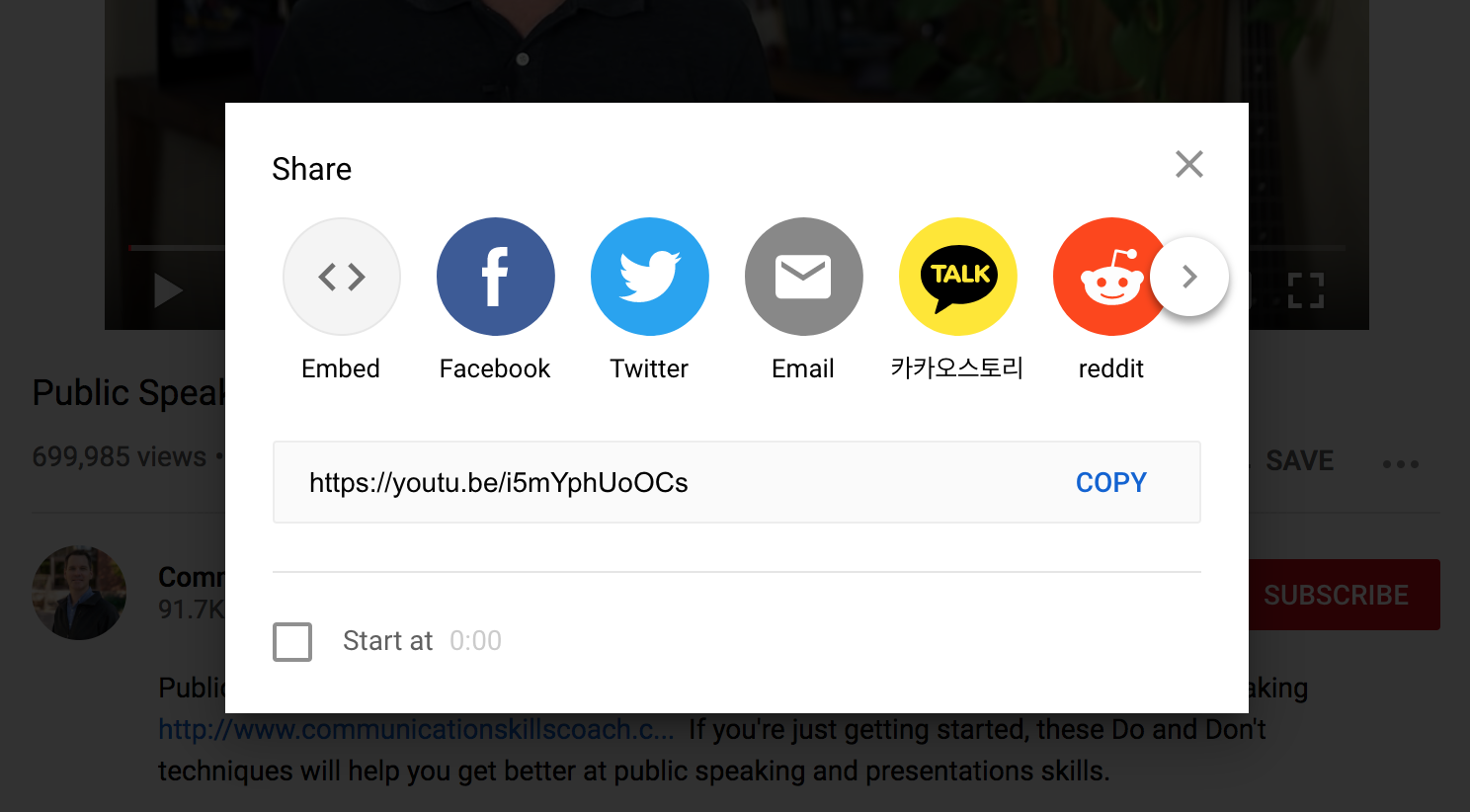
Think about it: who would willingly share a boring or uninformative video with their friends and family? Not many.
5. Likes and Dislikes
Likes and dislikes are also indicators of engagement that reveal how viewers feel about your video.
Obviously this is self explanatory: you'd prefer to have more likes than dislikes, wouldn't you? 🙂
You're Making Progress! 😎🙌
Great work! You've just completed the lesson on creating engaging videos to maximize audience retention, and you've gained insights into important YouTube ranking factors.
As you continue to apply these best practices to your videos, you'll notice improved results.
What's Up Next?
In the next lesson, we will look into YouTube SEO, or video search engine optimization (SEO).
These steps will be applied when you're ready to upload your video to YouTube.
We'll discuss how you can optimize your video's title, description, and more for your target keywords, ultimately enhancing your rankings and click-through rate.
- Part 1. YouTube Keyword Research: How To Get More Views?
- 👉 You're here: Part 2. How To Create Engaging YouTube Videos That Rank Higher
- Part 3. YouTube SEO 101: How To Boost Your Videos Search Ranking
- Part 4. Effective YouTube Video Promotion: Strategies to Boost Reach
